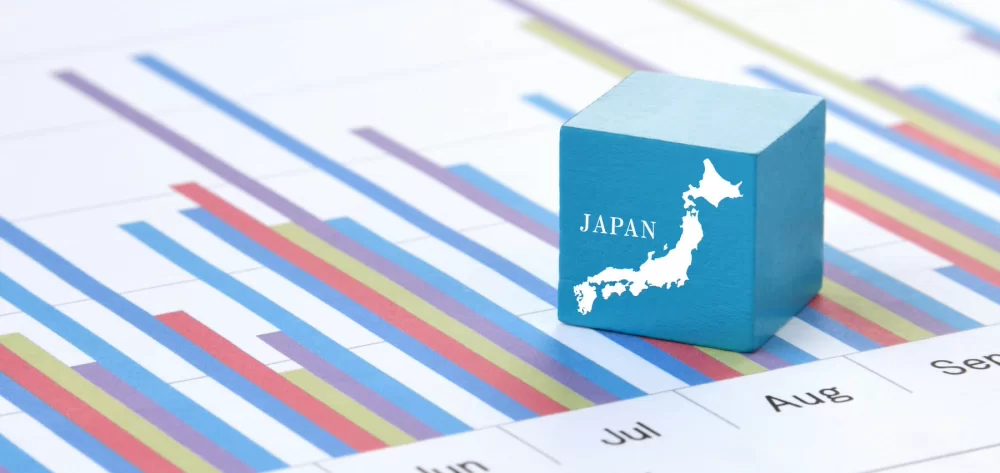Toyota, Sony, Nintendo, Fujifilm: Many Japanese companies are household names in Switzerland. The most important Japanese companies are tracked by the Nikkei 225 stock market index.
What is the Nikkei 225?
The Nikkei 225 is the most important Japanese stock market index, as well as the most important index in Asia as a whole. It is considered Japan’s primary stock index, and its influence reaches far beyond the country’s borders. The index is calculated by the Nihon Keizai Shimbun (Nikkei) newspaper. The stocks tracked by the index are traded on the Tokyo Stock Exchange.
The Nikkei 225 includes 225 blue chip stocks. Its components are reevaluated and adjusted on an annual basis. The term Nikkei 225 is generally used to denote the price index. A price index does not account for dividends. However, there is also a performance index version of the Nikkei 225 called the Nikkei 225 Total Return Index that accounts for shareholder dividends.
One peculiarity of the Nikkei 225 is the way that stocks are weighted in the index. The size of a stock’s component in the index is determined by its stock price in relation to the sum of all stock prices combined. So the primary criteria for the weighting of index components is a stock’s price, and not its market capitalization. The result is that stocks with a high per-share price are very strongly weighted in the index, which can result in distortions.
Table 1: The ten biggest index components in the Nikkei 225
| Stock |
Sector |
Index weighting |
| Fast Retailing |
Retail |
10.69% |
| Tokyo Electron |
Electronics |
6.40% |
| Softbank |
Telecom |
3.97% |
| Advantest |
Electronics |
3.29% |
| KDDI |
Telecom |
2.90% |
| Shin-Etsu Chemicals |
Chemicals |
2.41% |
| Daikin |
Machinery |
2.33% |
| Fanuc |
Electronics, machinery |
1.97% |
| TDK |
Electronics |
1.80% |
| Terumo |
Medical technology |
1.77% |
Source: Nikkei. Date: 21.11.2023
How accurately does the Nikkei 225 reflect the Japanese stock market?
With its 225 stocks, the Nikkei 225 is more diversified than other indexes like the Swiss Market Index (20 stocks) and the DAX (40 stocks). It covers the most important Japanese industrial companies. But because the influence of individual stocks on the index is determined by share prices instead of market capitalization, the index is not completely representative of the Japanese economy as a whole. For example, Japan’s most valuable company, the car-maker Toyota, makes up only around 1.4 percent of the index.
If you want to diversify your Japanese stock investment as broadly as possible, then the Tokyo Stock Price Index (Topix) is a more suitable option. The Topix index includes all publicly-traded Japanese companies, and is comparable with the Swiss Performance Index (SPI). Currently, the Topix index includes more than 2000 different companies. Additionally, the stocks that make up the Topix index are weighted based on their market capitalization, and not on their share prices.
How can I invest in the Nikkei 225?
There are several different ways to invest in the Nikkei 225. These options are available:
- The individual stocks of companies included in the Nikkei 225.
- ETFs that track the Nikkei 225.
- Actively-managed mutual funds.
- Tracker certificates that track the Nikkei 225.
- Fund savings plans with Nikkei 225 funds and ETFs.
- Online asset management services (robo advisors) that invest in the Nikkei 225.
Which ETFs can I use to invest in the Nikkei 225?
There are currently five different Nikkei 225 exchange-traded funds (ETFs) that make sense for Swiss private investors. The advantage of investing in ETFs is that you can invest in a huge portfolio of different stocks even if you only have relatively small amounts of capital. These funds are managed on a passive basis, which reduces their running expenses. Actively-managed funds are usually more expensive than ETFs.
Table 2: Nikkei 225 ETFs, sorted by their costs (TERs)
| Exchange-traded fund (ETF) |
ISIN |
Domicile of fund |
TER |
Dividends |
| Xtrackers Nikkei 225 UCITS ETF 1C |
LU2196470426 |
Luxembourg |
0.09% |
Accreting |
| Xtrackers Nikkei 225 UCITS ETF 1D |
LU0839027447 |
Luxembourg |
0.09% |
Distributing |
| Xtrackers Nikkei 225 UCITS ETF 2D EUR Hedged |
LU1875395870 |
Luxembourg |
0.19% |
Distributing |
| iShares Nikkei 225 UCITS ETF (Acc) |
IE00B52MJD48 |
Ireland |
0.48% |
Accreting |
| iShares Nikkei 225 UCITS ETF (DE) |
DE000A0H08D2 |
Germany |
0.51% |
Distributing |
Date: November 22, 2023.
The ETFs listed above are all physically replicating and not swap-based. Fully physically replicating ETFs are considered to be more secure than funds that use synthetic replication.
If your investment strategy targets growth, then you should focus on accreting funds. In an accreting fund, stock dividends are reinvested into the fund. But if, on the other hand, you aim to earn a regular income from your investments, then you should focus on distributing funds. For tax reasons, using ETFs that are domiciled in Ireland or Luxembourg is preferable.
What are the costs of using ETFs?
The fees charged by a fund are shown as a total expense ratio (TER). If a fund has a 0.2-percent TER and you use it to invest 1000 Swiss francs, then you will pay the fund a fee of 2 francs per year.
There are additional costs that you also need to consider. These include taxes, fees charged by stock exchanges, and brokerage fees and custody fees charged by your bank. The exact costs vary between banks. The moneyland.ch stock brokerage account comparison makes it easy to find the right account for your trading needs.
What are the advantages of investing in the Nikkei 225?
The main advantage of the Nikkei 225 is its relatively broad diversification. The Nikkei 225 also includes numerous heavyweight brands that have proven their value on an international scale over many years. Examples include carmakers Toyota, Honda, and Nissan, electronics giants Sony, Canon, and Epson, and entertainment companies Nintendo and Konami.
What are the disadvantages of investing in the Nikkei 225?
Investing in securities always comes with a certain amount of risk. Profits are never guaranteed, and losses can never be ruled out. That also holds true for the Nikkei 225. But the risk of loss is even higher if you invest in just a few individual companies.
Because of the way that the stocks making up the Nikkei 225 are weighted, the index does not completely represent Japan’s economy. Weighting stocks based on their share prices lends towards skewing effects. Certain companies and sectors could potentially be overrepresented, meaning they can have a disproportionate impact on the index’s development.
Additionally, there is also a currency exchange risk, as illustrated by the return comparison of the Nikkei 225 and the SMI (see Table 3). While the Nikkei 225 experienced stronger nominal growth than the Swiss index between 2018 and 2023, the devaluation of the Japanese yen against the Swiss franc largely negated the real returns.
Table 3: Comparison of gains in the Nikkei 225 and the SMI
| Index |
Performance in the local currency (2018-2023) |
Performance in CHF (2018-2023) |
| Price index |
| SMI |
21.95% |
21.95% |
| Nikkei 225 |
55.09% |
5.15% |
| Performance index |
| SMIC |
42.38% |
42.38% |
| Nikkei 225 Total Return Index |
71.45% |
16.25% |
The comparison is based on the trading days of November 21, 2018, and November 21, 2023. Source of performance data: Investing.com. Source of currency exchange rate data: Finanzen.ch
Conclusion
An investment in the Nikkei 225 can be used to diversify your investment portfolio. That is especially true if you use an affordable ETF. However, there are also notable disadvantages: namely the currency exchange rate risk, and the potential distortion effects caused by the index’s share-price-based makeup.
If you want to compensate for the skewed weighting and also get a more accurate picture of the Japanese economy, then the Topix may be a more suitable index for you.
More on this topic:
Compare Swiss stock brokerage accounts now
How to invest in the SMI
How to invest in the DAX
How to invest money in Switzerland




